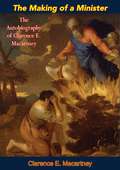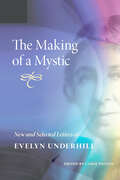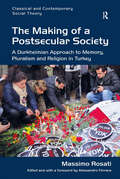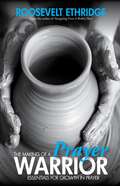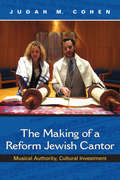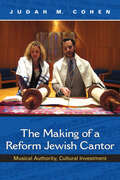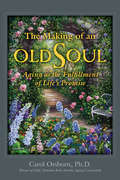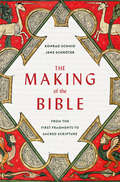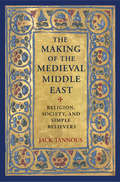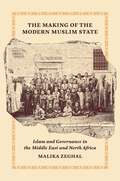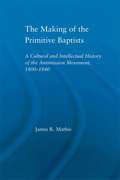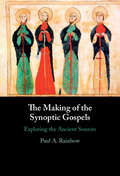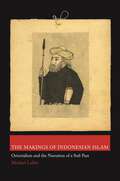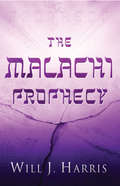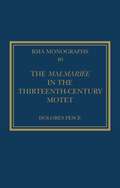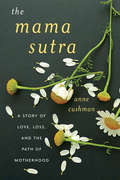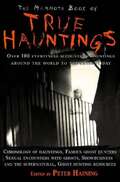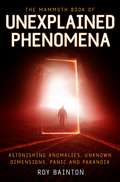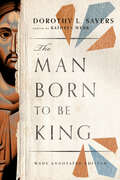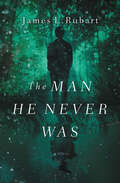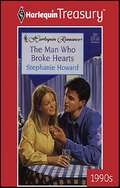- Table View
- List View
The Making of a Minister: The Autobiography of Clarence E. Macartney
by Clarence MacartneyOriginally published in 1961, The Making of a Minister is Clarence E. Macartney’s autobiography—the story of a man who was a great preacher, a Civil War scholar, a skilful and prolific writer, and the leader in the evangelical movement in its time of greatest crisis….A ‘minister’s minister,’ who, personifying the highest ideals of his calling, was also and foremost a ‘folk’ minister, with the compassionate heart of a true shepherd.
The Making of a Mystic: New and Selected Letters of Evelyn Underhill
by Evelyn UnderhillEvelyn Underhill (1875-1941) achieved international fame with the publication of her book Mysticism in 1911. Continuously in print since its original publication, Mysticism remains Underhill's most famous work, but in the course of her long career she published nearly forty books, including three novels and three volumes of poetry, as well as numerous poems in periodicals. She was the religion editor for Spectator, a friend of T. S. Eliot (her influence is visible in his last masterpiece, Four Quartets), and the first woman invited to lecture on theology at Oxford University. Her interest in religion extended beyond her Anglican upbringing to embrace the world's religions and their common spirituality. In time for the centennial celebration of her classic Mysticism, this volume of Underhill's letters will enable readers and researchers to follow her as she reconciled her beliefs with her daily life. The letters reveal her personal and theological development and clarify the relationships that influenced her life and work. Hardly aloof, she enjoyed the interests, mirth, and compassion of close friendships. Drawing from collections previously unknown to scholars, The Making of a Mystic shows the range of Evelyn Underhill's mind and interests as well as the immense network of her correspondents, including Sir James Frazier and Nobel Prize laureate Rabindranath Tagore. This substantial selection of Underhill's correspondence demonstrates an exceptional scope, beginning with her earliest letters from boarding school to her mother and extending to a letter written to T. S. Eliot from what was to be her deathbed in London in 1941 as the London Blitz raged around her.
The Making of a Postsecular Society: A Durkheimian Approach to Memory, Pluralism and Religion in Turkey (Classical and Contemporary Social Theory)
by Massimo RosatiDrawing on the thought of Durkheim, this volume focuses on societal changes at the symbolic level to develop a new conceptualisation of the emergence of postsecular societies. Neo-Durkheimian categories are applied to the case of Turkey, which in recent years has shifted from a strong Republican and Kemalist view of secularism to a more Anglo-Saxon perspective. Turkish society thus constitutes an interesting case that blurs modernist distinctions between the secular and the religious and which could be described as ’postsecular’. Presenting three symbolic case studies - the enduring image of the founder of the Republic Atatürk, the contested site of Ayasofia, and the remembering and commemoration of the murdered journalist Hrant Dink - The Making of a Postsecular Society analyses the cultural relationship that the modern Republic has always had with Europe, considering the possible implications of the Turkish model of secularism for a specifically European self-understanding of modernity. Based on a rigorous construction of theoretical categories and on a close scrutiny of the common challenges confronting Europe and its Turkish neighbour long considered ’other’ with regard to the accommodation of religious difference, this book sheds light on the possibilities for Europe to find new ways of arranging the relationship between the secular and the religious. As such, it will appeal to scholars of social theory, the sociology of religion, secularisation and religious difference, and social change.
The Making of a Prayer Warrior
by Roosevelt EthridgeThe Making of a Prayer Warrior is a systematic and detailed examination into the character and the life habits needed to become a watchman on the wall for the kingdom of God. This book will guide you in looking at all social factors that influence the life of an intercessor, from gender to personality to types of prayer. Roosevelt Ethridge Jr. uses his experience and wisdom to make the trials and triumphs of a life of intense prayer into clear, actionable nuggets of truth. Learn about the power of a life of supernatural prayer—prayer that heals the sick, changes lives, sees the miracles of God come to pass. Step from simple prayers into the life of a prayer warrior.
The Making of a Reform Jewish Cantor: Musical Authority, Cultural Investment
by Judah M. CohenThe Making of a Reform Jewish Cantor provides an unprecedented look into the meaning of attaining musical authority among American Reform Jews at the turn of the twenty-first century. How do aspiring cantors adapt traditional musical forms to the practices of contemporary American congregations? What is the cantor's role in American Jewish religious life today? Judah M. Cohen follows cantorial students at the School of Sacred Music, Hebrew Union College, over the course of their training, as they prepare to become modern Jewish musical leaders. Opening a window on the practical, social, and cultural aspects of aspiring to musical authority, this book provides unusual insights into issues of musical tradition, identity, gender, community, and high and low musical culture.
The Making of a Reform Jewish Cantor: Musical Authority, Cultural Investment (A\helen B. Schwartz Book In Jewish Studies)
by Judah M. Cohen“Of interest not only to cantors and their teachers but also to rabbis, congregations and everyone concerned about the future of the Jewish community.” —Florida Jewish JournalThe Making of a Reform Jewish Cantor provides an unprecedented look into the meaning of attaining musical authority among American Reform Jews at the turn of the twenty-first century. How do aspiring cantors adapt traditional musical forms to the practices of contemporary American congregations? What is the cantor’s role in American Jewish religious life today?Judah M. Cohen follows cantorial students at the School of Sacred Music, Hebrew Union College, over the course of their training, as they prepare to become modern Jewish musical leaders. Opening a window on the practical, social, and cultural aspects of aspiring to musical authority, this book provides unusual insights into issues of musical tradition, identity, gender, community, and high and low musical culture.
The Making of an Atheist: How Immorality Leads to Unbelief
by James SpiegelThe new atheists are on the warpath. They come armed with arguments to show that belief in God is absurd and dangerous. In the name of societal progress, they promote purging the world of all religious practice. And they claim that people of faith are mentally ill. Some of the new atheists openly declare their hatred for the Judeo-Christian God.Christian apologists have been quick to respond to the new atheists&’ arguments. But there is another dimension to the issue which begs to be addressed--the root causes of atheism. Where do atheists come from? How did such folks as Richard Dawkins, Sam Harris, Daniel Dennett, and Christopher Hitchens become such ardent atheists? If we are to believe them, their flight from faith resulted from a dispassionate review of the evidence. Not enough rational grounds for belief in God, they tell us. But is this the whole story?Could it be that their opposition to religious faith has more to do with passion than reason? What if, in the end, evidence has little to do with how atheists arrive at their anti-faith? That is precisely the claim in this book. Atheism is not at all a consequence of intellectual doubts. These are mere symptoms of the root cause--moral rebellion. For the atheist, the missing ingredient is not evidence but obedience.The psalmist declares, &“The fool says in his heart there is no God&” (Ps. 14:1), and in the book of Romans, Paul makes it clear that lack of evidence is not the atheist&’s problem. The Making of an Atheist confirms these biblical truths and describes the moral and psychological dynamics involved in the abandonment of faith.
The Making of an Atheist: How Immorality Leads to Unbelief
by James SpiegelThe new atheists are on the warpath. They come armed with arguments to show that belief in God is absurd and dangerous. In the name of societal progress, they promote purging the world of all religious practice. And they claim that people of faith are mentally ill. Some of the new atheists openly declare their hatred for the Judeo-Christian God.Christian apologists have been quick to respond to the new atheists&’ arguments. But there is another dimension to the issue which begs to be addressed--the root causes of atheism. Where do atheists come from? How did such folks as Richard Dawkins, Sam Harris, Daniel Dennett, and Christopher Hitchens become such ardent atheists? If we are to believe them, their flight from faith resulted from a dispassionate review of the evidence. Not enough rational grounds for belief in God, they tell us. But is this the whole story?Could it be that their opposition to religious faith has more to do with passion than reason? What if, in the end, evidence has little to do with how atheists arrive at their anti-faith? That is precisely the claim in this book. Atheism is not at all a consequence of intellectual doubts. These are mere symptoms of the root cause--moral rebellion. For the atheist, the missing ingredient is not evidence but obedience.The psalmist declares, &“The fool says in his heart there is no God&” (Ps. 14:1), and in the book of Romans, Paul makes it clear that lack of evidence is not the atheist&’s problem. The Making of an Atheist confirms these biblical truths and describes the moral and psychological dynamics involved in the abandonment of faith.
The Making of an Old Soul: Aging as the Fulfillment of Life's Promise
by Carol OrsbornThe Making of an Old Soul: Aging as the Fulfillment of Life’s Promise is the healing vision of a woman who is a scholar in the fields of adult and spiritual development as well as a lifelong seeker. Based on a mystical experience that sheds light on the entire arc of life, Orsborn’s latest work revisions age not as diminishment but as the fulfillment of life’s promise. Bursting through the stereotypes into a world of old souls, Orsborn shows you how to embrace the luminous spirit within that beats steadily beyond the wounds of childhood, beyond the unintended consequences of your best-intentions, beyond the twists and turns of fate over which even at the peak of the developmental pyramid you have no control. This gem of a book affirms that hope is merited and that seekers of all ages and circumstances have what it takes to grow not just old, but old souls.
The Making of the Bible: From the First Fragments to Sacred Scripture
by Jens Schröter Konrad SchmidThe authoritative new account of the Bible’s origins, illuminating the 1,600-year tradition that shaped the Christian and Jewish holy books as millions know them today. The Bible as we know it today is best understood as a process, one that begins in the tenth century BCE. In this revelatory account, a world-renowned scholar of Hebrew scripture joins a foremost authority on the New Testament to write a new biography of the Book of Books, reconstructing Jewish and Christian scriptural histories, as well as the underappreciated contest between them, from which the Bible arose. Recent scholarship has overturned popular assumptions about Israel’s past, suggesting, for instance, that the five books of the Torah were written not by Moses but during the reign of Josiah centuries later. The sources of the Gospels are also under scrutiny. Konrad Schmid and Jens Schröter reveal the long, transformative journeys of these and other texts en route to inclusion in the holy books. The New Testament, the authors show, did not develop in the wake of an Old Testament set in stone. Rather the two evolved in parallel, in conversation with each other, ensuring a continuing mutual influence of Jewish and Christian traditions. Indeed, Schmid and Schröter argue that Judaism may not have survived had it not been reshaped in competition with early Christianity. A remarkable synthesis of the latest Old and New Testament scholarship, The Making of the Bible is the most comprehensive history yet told of the world’s best-known literature, revealing its buried lessons and secrets.
The Making of the Global Yijing in the Modern World: Cross-cultural Interpretations and Interactions (Chinese Culture #4)
by Benjamin Wai-ming NgThis book represents an ambitious effort to bring leading Yijing scholars together to examine the globalisation and localisation of the 'Book of Changes' from cross-cultural and comparative perspectives. It focuses on how the Yijing has been used to support ideologies, converted into knowledge, and assimilated into global cultures in the modern period, transported from the Sinosphere to British, American and French cultural traditions, travelling from East Asia to Europe and the United States. The book provides conceptualised narratives and cross-cultural analyses of the global popularisation and local assimilation of the Yijing, highlighting the transformation and application of the Yijing in different cultural traditions, and demonstrating how it acquired different meanings and took on different roles in the context of a global setting. In presenting a novel contribution to understandings of the multifaceted nature of the Yijing, this book is essential reading for scholars and students interested in the 'Classic of Changes'. It is also a useful reference for those studying Chinese culture, Asian philosophy, East Asian studies, and translation studies.
The Making of the Medieval Middle East: Religion, Society, and Simple Believers
by Jack TannousA bold new religious history of the late antique and medieval Middle East that places ordinary Christians at the center of the storyIn the second half of the first millennium CE, the Christian Middle East fractured irreparably into competing churches and Arabs conquered the region, setting in motion a process that would lead to its eventual conversion to Islam. Jack Tannous argues that key to understanding these dramatic religious transformations are ordinary religious believers, often called “the simple” in late antique and medieval sources. Largely agrarian and illiterate, these Christians outnumbered Muslims well into the era of the Crusades, and yet they have typically been invisible in our understanding of the Middle East’s history.What did it mean for Christian communities to break apart over theological disagreements that most people could not understand? How does our view of the rise of Islam change if we take seriously the fact that Muslims remained a demographic minority for much of the Middle Ages? In addressing these and other questions, Tannous provides a sweeping reinterpretation of the religious history of the medieval Middle East.This provocative book draws on a wealth of Greek, Syriac, and Arabic sources to recast these conquered lands as largely Christian ones whose growing Muslim populations are properly understood as converting away from and in competition with the non-Muslim communities around them.
The Making of the Modern Muslim State: Islam and Governance in the Middle East and North Africa (Princeton Studies in Muslim Politics #90)
by Malika ZeghalAn innovative analysis that traces the continuity of the state&’s custodianship of Islam as the preferred religion in the Middle East and North Africa In The Making of the Modern Muslim State, Malika Zeghal reframes the role of Islam in modern Middle East governance. Challenging other accounts that claim that Middle Eastern states turned secular in modern times, Zeghal shows instead the continuity of the state&’s custodianship of Islam as the preferred religion. Drawing on intellectual, political, and economic history, she traces this custodianship from early forms of constitutional governance in the nineteenth century through post–Arab Spring experiments in democracy. Zeghal argues that the intense debates around the implementation and meaning of state support for Islam led to a political cleavage between conservatives and their opponents that long predated the polarization of the twentieth century that accompanied the emergence of mass politics and Islamist movements.Examining constitutional projects, public spending, school enrollments, and curricula, Zeghal shows that although modern Muslim-majority polities have imported Western techniques of governance, the state has continued to protect and support the religion, community, and institutions of Islam. She finds that even as Middle Eastern states have expanded their nonreligious undertakings, they have dramatically increased their per capita supply of public religious provisions, especially Islamic education—further feeding the political schism between Islamists and their adversaries. Zeghal illuminates the tensions inherent in the partnerships between states and the body of Muslim scholars known as the ulama, whose normative power has endured through a variety of political regimes. Her detailed and groundbreaking analysis, which spans Tunisia, Morocco, Egypt, Turkey, Syria, and Lebanon, makes clear the deep historical roots of current political divisions over Islam in governance.
The Making of the Primitive Baptists: A Cultural and Intellectual History of the Anti-Mission Movement, 1800-1840 (Studies in American Popular History and Culture)
by James R. MathisThis study describes the creation of the Primitive Baptist movement and discusses the main outlines of their thought. It also weaves the story of the Primitive Baptists with other developments in American Christianity in the Early Republic.
The Making of the Synoptic Gospels: Exploring the Ancient Sources
by Paul A. RainbowWhy are the Gospels of Matthew, Mark, and Luke so similar, yet different? Modern scholars have developed four main approaches to the synoptic problem: That the evangelists tapped into testimonies about Jesus, or drew from many written fragments, or used a common exemplar, or modified each other's work. The first three approaches find solid support in antiquity, yet ironically, the fourth approach dominates gospel scholarship, without producing any consensus. In this study, Paul A. Rainbow reclaims the discarded proto-gospel hypothesis of the earliest modern critics, based on a fresh reading of traditions recorded by Papias in the early second century CE. He challenges the Utilization hypotheses – that the synoptists adapted the work of each other, in various theoretical configurations – by offering an historically nuanced hypothesis of a proto-gospels, which the three evangelists independently translated into Greek from Hebrew and enriched with oral testimonies and written fragments available to them.
The Makings of Indonesian Islam: Orientalism and the Narration of a Sufi Past (Princeton Studies in Muslim Politics #42)
by Michael LaffanIndonesian Islam is often portrayed as being intrinsically moderate by virtue of the role that mystical Sufism played in shaping its traditions. According to Western observers--from Dutch colonial administrators and orientalist scholars to modern anthropologists such as the late Clifford Geertz--Indonesia's peaceful interpretation of Islam has been perpetually under threat from outside by more violent, intolerant Islamic traditions that were originally imposed by conquering Arab armies. The Makings of Indonesian Islam challenges this widely accepted narrative, offering a more balanced assessment of the intellectual and cultural history of the most populous Muslim nation on Earth. Michael Laffan traces how the popular image of Indonesian Islam was shaped by encounters between colonial Dutch scholars and reformist Islamic thinkers. He shows how Dutch religious preoccupations sometimes echoed Muslim concerns about the relationship between faith and the state, and how Dutch-Islamic discourse throughout the long centuries of European colonialism helped give rise to Indonesia's distinctive national and religious culture. The Makings of Indonesian Islam presents Islamic and colonial history as an integrated whole, revealing the ways our understanding of Indonesian Islam, both past and present, came to be.
The Malachi Prophecy
by Will J. HarrisAs God&’s &“last word&” from the prophetic age, Malachi holds great portent. The Malachi Prophecy explores its dire warnings, delivered to a nation (perhaps like our own) weary of their God and forgetful of His purpose, and illuminates its foreshadowing of the gospel that would come to Israel 400 years later, as well as before the Messianic Age. Malachi declared to Jews of his day (and to the faithful of our own age) who &“remember&” the Lord that He would write their names in His &“book of remembrance&” and &“spare&” them for Himself (Mal. 3:17). Ultimately, as Romans 11:26 prophesies, &“all Israel will be saved.&” Until then, The Malachi Prophecy, like Will J. Harris&’s The Messiah Question, provides abundant scriptural resources for reaching unbelieving Jews with the good news of their Messiah.
The Malmariée in the Thirteenth-Century Motet (Royal Musical Association Monographs)
by Dolores PesceThis monograph offers a comprehensive study of the topos of the malmariée or the unhappily married woman within the thirteenth-century motet repertory, a vocal genre characterized by several different texts sounding simultaneously over a foundational Latin chant. Part I examines the malmariée motets from three vantage points: (1) in light of contemporaneous canonist views on marriage; (2) to what degree the French malmariée texts in the upper voices treat the messages inherent in the underlying Latin chant through parody and/or allegory; and (3) interactions among upper-voice texts that invite additional interpretations focused on gender issues. Part II investigates the transmission profile of the motets, as well as of their refrains, revealing not only intertextual refrain usage between the motets and other genres, but also a significant number of shared refrains between malmariée motets and other motets. Part II furthermore offers insights on the chronology of composition within a given intertextual refrain nexus, and examines how a refrain’s meaning can change in a new context. Finally, based on the transmission profile, Part II argues for a lively interest in the topos in the 1270s and 1280s, both through composition of new motets and compilation of earlier ones, with Paris and Arras playing a prominent role.
The Mama Sutra: A Story of Love, Loss, and the Path of Motherhood
by Anne CushmanA heartfelt memoir of motherhood as a spiritual practice by a longtime yoga and dharma teacher.Sutra is the Sanskrit name for a short spiritual teaching, and it comes from the same root as the English word suture, or stitch. This story of motherhood as a path to awakening is, says yoga and meditation teacher Anne Cushman, “an homage to the long threads that run through all human lives, stitching up what’s shredded in our hearts.” The Mama Sutra spans an eighteen-year journey through motherhood as a spiritual practice, chronicling Cushman’s first pregnancy, her daughter's tragic stillbirth, the joyful birth of her son, the “home retreat” of early motherhood, the challenges of parenthood, the diagnosis and gifts of her son’s developmental differences, the meltdown of her nuclear family and its reconfiguration into a new and joyful form, and more. This is a powerful story of the rawness and beauty of life.
The Mammoth Book of True Hauntings (Mammoth Books #270)
by Peter HainingThis giant collection includes a huge range of 20th-century first-hand accounts of hauntings, such as the American troops who repeatedly saw the ghosts of a dead platoon of men while on patrol in Vietnam; and the witnessed haunting of a house near Tintagel in Cornwall that led actress Kate Winslet to pull out of buying the property.It covers the full spectrum of credible hauntings, from poltergeists (the noisy, dangerous and frightening spirits that are usually associated with pubescent girls, like the Bell Witch), to phantoms (like the Afrits of Saudi Arabia) and seduction spirits (such as the Lorelei, which have lured German men to death).Also included are the notes of the most famous ghost hunters of the twentieth century such as Hans Holzer, Susy Smith (USA); Harry Price, Jenny Randles (UK); Joyce Zwarycz (Australia), Eric Rosenthal (South Africa), and Hwee Tan (Japan). Plus essays by such names as Robert Graves, Edgar Cayce, and M. R. James outlining their own - often extraordinary - conclusions as to just what ghosts might be; along with a full bibliography and list of useful resources.Praise for MBO Haunted House Stories:'A first rate list of contributors ... Hair raising!' Time Out'All we need say is buy it.' Starlog
The Mammoth Book of Unexplained Phenomena: From bizarre biology to inexplicable astronomy (Mammoth Books #190)
by Roy BaintonNew mysteries, as well as variations on recurring ones, continue to surface on a weekly basis around the globe, from showers of frogs over Hungary to birds falling to earth in Arkansas. This compendious round-up of unexplained phenomena examines everything from the experiments being done with the Large Hadron Collider to classic maritime mysteries involving inexplicably missing crews, via UFOs, mediums, cryptozoology, panics, paranoia and a universe proving stranger in fact than we'd imagined.
The Man Born to Be King: Wade Annotated Edition
by Dorothy L. SayersFrom December 1941 until October 1942, the BBC broadcast a series of radio dramas written by Dorothy L. Sayers.Noted for their use of colloquial English as part of Sayers's effort to bring the Gospels to life in a new way for listeners, the plays were both controversial and incredibly successful, bolstering the morale of the country during the war. They were subsequently published in 1943, and they stand among Sayers's most beloved works to this day.In this new critical and annotated edition, scholar Kathryn Wehr brings fresh insights to the plays, their background, Sayers's creative process, and the ongoing significance of the life of Christ today. Listen again, or for the first time, to the story of the man who was born to be—and still is—king.
The Man Code: Unlock the Secret
by Dennis Swanberg Ron SmithWe men are so predictable. As a way of avoiding even the most remote possibility of authentic relationships, most of us are quick to form a complex web of surface-level friendships, an ever-expanding collection of "buddies." Yet we never manage to develop even one really close friendship. The Man Code is a powerful tool to help men reorganize their thoughts and revolutionize their lives by learning to form meaningful relationships, starting with God and branching out from there. The code is 1, 3, 12, 120, 3000, and by mastering the relationships these five numbers represent, men will establish the right priorities, make the right plans, diagnose unforeseen difficulties, make mid-course corrections and achieve the positive results that they desire and God intends.
The Man He Never Was: A Novel
by James L. RubartIn this fresh take on the classic Dr. Jekyll and Mr. Hyde, James L. Rubart explores the war between good and evil within each of us—and one man&’s only chance to overcome the greatest divide of the soul.What if you woke up one morning and the darkest parts of yourself were gone?Torren Daniels vanished eight months back, and his wife and kids have moved on—with more than a little relief. Toren was a good man but carried a raging temper that often exploded without warning. So when he shows up on their doorstep out of the blue, they&’re shocked to see him alive. But more shocked to see he&’s changed. Radically.His anger is gone. He&’s oddly patient. Kind. Fun. The man he always wanted to be. Toren has no clue where he&’s been but he knows he&’s been utterly transformed. He focuses on three things: Finding out where he&’s been. Finding out how it happened. And winning back his family.But as the months go on, his memory slowly returns. And the more the memories come, the more Torren slips back into being the man he was before. How can he hang on to the new man he&’s become? And who is he really? The man he was . . . or the man he is?Praise for The Man He Never Was:&“With plenty of twists and turns to keep the pages turning, The Man He Never Was expertly explores the difference between knowing and experiencing, and asks the important question: What might happen if we could see the person in the mirror as God does?&” —Katie Ganshert, award-winning author of Life After&“This is no mere novel, but a journey to the soul. Sage, deep filled with a truth of terrible beauty and the real nature of love.&” —Tosca Lee, New York Times bestselling author&“In The Man He Never Was, James L. Rubart perplexes readers in the best possible way, wooing us through the mystery of a man&’s lost memory and the high stakes of his broken marriage, failed career, and an unbridled anger problem. A page-turning exploration of what it means to live truly loved.&” —Mary DeMuth, author of The Muir House
The Man Who Broke Hearts
by Stephanie HowardThe rake's revenge?They had worked together before, but then it was Justin who had taken Tina's love, casually tossed it aside and moved on to his next conquest. Now she was back in his employ, and Justin was treating her as if she were guilty of betraying him! He was also intent on revenge. Yet she was the injured party! Something just didn't add up. Tina was determined to find out what, and maybe, in the process, win the love of the man she had always wanted.
